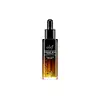What's inside
What's inside
 Key Ingredients
Key Ingredients

 Benefits
Benefits

 Concerns
Concerns

 Ingredients Side-by-side
Ingredients Side-by-side

Aloe Barbadensis Leaf Juice
Skin ConditioningWater
Skin ConditioningGlycereth-26
Humectant3-O-Ethyl Ascorbic Acid
Skin ConditioningGlycerin
HumectantPropylene Glycol
HumectantButylene Glycol
HumectantSwiftlet Nest Extract
Skin ConditioningOpuntia Ficus-Indica Stem Extract
Skin ConditioningAnthemis Nobilis Flower Extract
MaskingEctoin
Skin ConditioningCitrus Aurantium Dulcis Fruit Extract
MaskingChondrus Crispus Extract
Skin ConditioningInonotus Obliquus Extract
Skin ConditioningTrehalose
HumectantSodium PCA
HumectantSodium Polyglutamate
HumectantPhenoxyethanol
PreservativeBiosaccharide Gum-1
HumectantAcetyl Tyrosine
Skin ConditioningProline
Skin ConditioningHydrolyzed Vegetable Protein
Skin ConditioningAdenosine Triphosphate
Skin ConditioningJojoba Wax PEG-120 Esters
Arginine
MaskingPEG-40 Hydrogenated Castor Oil
EmulsifyingCopper Tripeptide-1
Skin ConditioningColloidal Gold
AntimicrobialHyaluronic Acid
HumectantSodium Hyaluronate
HumectantAllantoin
Skin ConditioningSodium Hyaluronate Crosspolymer
HumectantDipotassium Glycyrrhizate
HumectantCaffeine
Skin ConditioningCarbomer
Emulsion StabilisingCitric Acid
BufferingCitrus Aurantium Bergamia Fruit Oil
MaskingCitrus Aurantium Dulcis Flower Oil
AstringentCitrus Junos Fruit Oil
MaskingCitrus Limon Peel Oil
MaskingAloe Barbadensis Leaf Juice, Water, Glycereth-26, 3-O-Ethyl Ascorbic Acid, Glycerin, Propylene Glycol, Butylene Glycol, Swiftlet Nest Extract, Opuntia Ficus-Indica Stem Extract, Anthemis Nobilis Flower Extract, Ectoin, Citrus Aurantium Dulcis Fruit Extract, Chondrus Crispus Extract, Inonotus Obliquus Extract, Trehalose, Sodium PCA, Sodium Polyglutamate, Phenoxyethanol, Biosaccharide Gum-1, Acetyl Tyrosine, Proline, Hydrolyzed Vegetable Protein, Adenosine Triphosphate, Jojoba Wax PEG-120 Esters, Arginine, PEG-40 Hydrogenated Castor Oil, Copper Tripeptide-1, Colloidal Gold, Hyaluronic Acid, Sodium Hyaluronate, Allantoin, Sodium Hyaluronate Crosspolymer, Dipotassium Glycyrrhizate, Caffeine, Carbomer, Citric Acid, Citrus Aurantium Bergamia Fruit Oil, Citrus Aurantium Dulcis Flower Oil, Citrus Junos Fruit Oil, Citrus Limon Peel Oil
Water
Skin ConditioningGlycerin
HumectantButylene Glycol
HumectantNiacinamide
SmoothingDibutyl Adipate
EmollientCaprylic/Capric Triglyceride
Masking1,2-Hexanediol
Skin ConditioningHydrogenated Lecithin
EmulsifyingAmmonium Acryloyldimethyltaurate/Vp Copolymer
Helianthus Annuus Seed Oil
EmollientCholesterol
EmollientAllantoin
Skin ConditioningGlycine Soja Oil
EmollientTocopherol
AntioxidantTocopheryl Acetate
AntioxidantSodium Methyl Stearoyl Taurate
CleansingPropanediol
SolventDaucus Carota Sativa Root Extract
Skin ConditioningEthylhexylglycerin
Skin ConditioningAdenosine
Skin ConditioningAsiaticoside
AntioxidantMadecassic Acid
Skin ConditioningCamellia Sinensis Seed Extract
HumectantAsiatic Acid
Skin ConditioningRetinol
Skin ConditioningStearyl Glycyrrhetinate
Skin ConditioningHyaluronic Acid
HumectantMannitol
HumectantCeramide NP
Skin ConditioningBeta-Glucan
Skin ConditioningBeta-Carotene
Skin ConditioningPhytosphingosine
Skin ConditioningBHT
AntioxidantSalicylic Acid
MaskingAcetyl Tetrapeptide-11
Skin ConditioningWater, Glycerin, Butylene Glycol, Niacinamide, Dibutyl Adipate, Caprylic/Capric Triglyceride, 1,2-Hexanediol, Hydrogenated Lecithin, Ammonium Acryloyldimethyltaurate/Vp Copolymer, Helianthus Annuus Seed Oil, Cholesterol, Allantoin, Glycine Soja Oil, Tocopherol, Tocopheryl Acetate, Sodium Methyl Stearoyl Taurate, Propanediol, Daucus Carota Sativa Root Extract, Ethylhexylglycerin, Adenosine, Asiaticoside, Madecassic Acid, Camellia Sinensis Seed Extract, Asiatic Acid, Retinol, Stearyl Glycyrrhetinate, Hyaluronic Acid, Mannitol, Ceramide NP, Beta-Glucan, Beta-Carotene, Phytosphingosine, BHT, Salicylic Acid, Acetyl Tetrapeptide-11
 Reviews
Reviews

Ingredients Explained
These ingredients are found in both products.
Ingredients higher up in an ingredient list are typically present in a larger amount.
Allantoin is a soothing ingredient known for its protective and moisturizingg properties. Because of this, it is often added to products with strong active ingredients.
Studies show higher concentrations of this ingredient can promote wound healing.
Though it can be derived from the comfrey plant, allantoin is produced synthetically for cosmetic products to ensure purity.
Learn more about AllantoinButylene Glycol (or BG) is used within cosmetic products for a few different reasons:
Overall, Butylene Glycol is a safe and well-rounded ingredient that works well with other ingredients.
Though this ingredient works well with most skin types, some people with sensitive skin may experience a reaction such as allergic rashes, closed comedones, or itchiness.
Learn more about Butylene GlycolGlycerin is already naturally found in your skin. It helps moisturize and protect your skin.
A study from 2016 found glycerin to be more effective as a humectant than AHAs and hyaluronic acid.
As a humectant, it helps the skin stay hydrated by pulling moisture to your skin. The low molecular weight of glycerin allows it to pull moisture into the deeper layers of your skin.
Hydrated skin improves your skin barrier; Your skin barrier helps protect against irritants and bacteria.
Glycerin has also been found to have antimicrobial and antiviral properties. Due to these properties, glycerin is often used in wound and burn treatments.
In cosmetics, glycerin is usually derived from plants such as soybean or palm. However, it can also be sourced from animals, such as tallow or animal fat.
This ingredient is organic, colorless, odorless, and non-toxic.
Glycerin is the name for this ingredient in American English. British English uses Glycerol/Glycerine.
Learn more about GlycerinHyaluronic acid is naturally found in healthy skin. It is a humectant, meaning it draws moisture to your skin.
This ingredient helps hydrate, soothe, and protect the skin.
What makes hyaluronic acid so hydrating? It has the capacity to bind or hold large amounts of water.
Fun fact: It is already naturally found in our bodies, such as the fluids of our eyes and our joints.
Studies find this ingredient to have anti-inflammatory and anti-microbial properties. This can help speed up wound-healing.
Hyaluronic acid can be irritating if the molecule has a low-molecular weight, or if the molecules are small.
One study found low-molecular weight hyaluronic acid to be pro-inflammatory, meaning some people may experience irritation. This is because our bodies use hyaluronic acid in the wound-healing process to signal to our bodies, via irritation, that something needs healing.
The same study found high-molecular weight hyaluronic acid to be anti-inflammatory.
These are some other common types of Hyaluronic Acid:
Learn more about Hyaluronic AcidWater. It's the most common cosmetic ingredient of all. You'll usually see it at the top of ingredient lists, meaning that it makes up the largest part of the product.
So why is it so popular? Water most often acts as a solvent - this means that it helps dissolve other ingredients into the formulation.
You'll also recognize water as that liquid we all need to stay alive. If you see this, drink a glass of water. Stay hydrated!
Learn more about Water